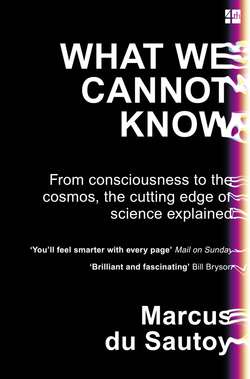Читать книгу What We Cannot Know: Explorations at the Edge of Knowledge - Marcus Sautoy du - Страница 55
MAPPING THE PARTICLE ZOO
ОглавлениеWhen you are trying to classify things, it helps to recognize the dominant characteristics that can gather a large mess of objects into smaller groups. In the case of animals, the idea of species creates some order in the animal kingdom. In particle physics one important invariant that helped divide the zoo into smaller groups was the idea of charge. How does the particle interact with the electromagnetic force? Electrons would bend one way, protons the other, and the neutron would be unaffected.
As these new particles emerged from the undergrowth, they could be passed through the gateway of the electromagnetic force. Some would join the electron’s cage, others would head towards the proton, and the rest would be put together with the neutron – a first pass at imposing some order on the menagerie of particles.
But the electromagnetic force is one of four fundamental forces that have been identified at work in bringing the universe together. The other forces are gravity, and the strong nuclear force responsible for binding protons and neutrons together at close quarters inside the nucleus, and finally the weak nuclear force that controls things like radioactive decay.
The key was to identify other characteristics similar to the idea of charge that could distinguish the different behaviours of these particles with the other fundamental forces. For example, the mass of a particle was actually quite a good way of establishing some hierarchy in the particle zoo. It collected pions and kaons together as particles that were a factor lighter than the protons or neutrons that made up ordinary matter. A new collection of particles called Sigma, Xi and Lambda baryons had masses larger than the proton and neutron and often decayed into protons or neutrons.
Often particles with very similar masses got the same Greek names. Indeed, the proton and neutron have such similar masses that they were believed to be intimately related, so much so that the German physicist Werner Heisenberg (whose ideas will be at the heart of the next Edge) rechristened them nucleons. But mass was a rather rough and ready way of sorting these particles. Physicists were on the lookout for something more fundamental: a pattern as effective as the one Mendeleev had discovered to order atoms.
The key to finding patterns to make sense of the onslaught of new particles was a new property called strangeness. The name arose due to the rather strange behaviour demonstrated by some of these new particles as they decayed. Since mass is equivalent to energy via Einstein’s equation E=mc2, and nature favours low-energy states, particles with larger mass often try to find ways to decay into particles with smaller mass.
There are several mechanisms for this decay, each depending on one of the fundamental forces. Each mechanism has a characteristic signature which helps physicists to understand which fundamental force is causing the decay. Again it’s energy considerations that control which is the most likely force at work in any particle decay. The strong nuclear force is usually the first to have a go at decaying a particle, and this will generally decay the particle within 10–24 of a second. Next in the hierarchy is the electromagnetic force, which might result in the emission of photons. The weak nuclear force is the most costly in energy terms and so takes longer. A particle that decays via the weak nuclear force is likely to take 10–11 seconds before it decays. So by observing the time it takes to decay, scientists can get some indication of which force is at work.
For example, a Delta baryon decays in 6 × 10–24 seconds to a proton and a pion via the strong nuclear force, while a Sigma baryon takes 8 × 10–11 seconds to decay to the same proton and pion. The longer time of decay indicates that it is controlled by the weak nuclear force. In the middle we have the example of a neutrally charged pion decaying via the electromagnetic force into two photons, which happens in 8.4 × 10–17 seconds.
Imagine a ball sitting in a valley. There is a path to the right which, with a little push, will take the ball over the hill into a lower valley. This path corresponds to the strong nuclear force. To the left is a higher hill which is also a path to a lower energy state. This direction represents the work of the weak nuclear force.
A Delta baryon ∆ decays via the strong nuclear force to a proton and a pion. In contrast, a Sigma baryon ∑ decays via the weak nuclear force.
So why did the Delta baryon find a way over the easy hill while the Sigma baryon went the long way? This seemed rather strange. There appeared to be certain particles that encountered a barrier (represented in the figure by a broken line) that prevented them from crossing via the easy route to the lower valley.
